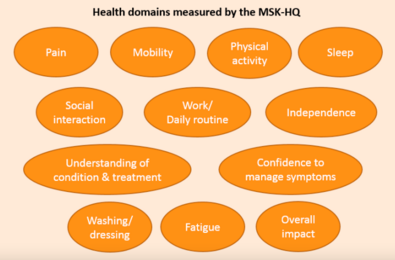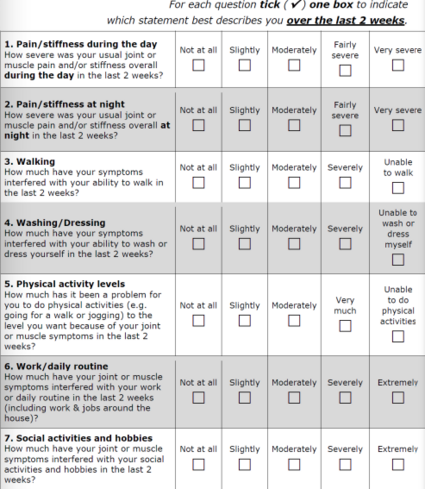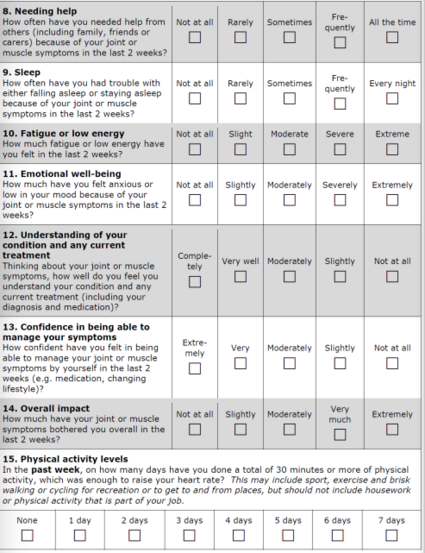Musculoskeletal Health Questionnaire: Difference between revisions
Maram Salem (talk | contribs) (Added information under headings, added media/images and references) |
Maram Salem (talk | contribs) (edited photo for questionnaire, added more information for method of use) |
||
| Line 15: | Line 15: | ||
== Intended Population == | == Intended Population == | ||
The MSK-HQ is intended for patients with any musculoskeletal condition.<ref>Price AJ, Ogollah R, Kang S, et al. Determining responsiveness and meaningful changes for the Musculoskeletal Health Questionnaire (MSK-HQ) for use across musculoskeletal care pathways. BMJ Open 2019;9:e025357.</ref> It is a questionnaire that is responsive to change across a range of musculoskeletal conditions over the course of treatment, with patients reporting that the outcome measure was highly relevant and easy to understand.<ref name=":1" /> | The MSK-HQ is intended for patients with any musculoskeletal condition.<ref name=":2">Price AJ, Ogollah R, Kang S, et al. Determining responsiveness and meaningful changes for the Musculoskeletal Health Questionnaire (MSK-HQ) for use across musculoskeletal care pathways. BMJ Open 2019;9:e025357.</ref> It is a questionnaire that is responsive to change across a range of musculoskeletal conditions over the course of treatment, with patients reporting that the outcome measure was highly relevant and easy to understand.<ref name=":1" /> | ||
== Method of Use == | == Method of Use == | ||
| Line 32: | Line 32: | ||
# overall impact from symptoms | # overall impact from symptoms | ||
Patients are given the questionnaire prior to the start of their physical therapy plan of care. Patients are instructed to check a box in each of the domains listed. It is a a 5-point scale, "4" representing "not at all" and "0" representing "very severe." | Patients are given the questionnaire prior to the start of their physical therapy plan of care. Patients are instructed to check a box in each of the domains listed. It is a a 5-point scale, "4" representing "not at all" and "0" representing "very severe." Following physical therapy treatment, patients are asked to complete the questionnaire again. It is important to note that items 12 and 13 on the form have the responses listed in reverse order.<ref name=":2" /> | ||
[[File: | |||
All 14 items are summed together with a maximum total of 56 points. | |||
[[File:MSKHQ1.png|left|thumb|489x489px]] | |||
[[File:MSK-HQpg2.png|thumb|553x553px]] | |||
A sample of the Musculoskeletal Health Questionnaire can be found [https://versusarthritis.org/media/7833/msk-hq-2018.pdf here]. | |||
== Evidence == | == Evidence == | ||
Revision as of 20:37, 24 November 2023
This article or area is currently under construction and may only be partially complete. Please come back soon to see the finished work! (24/11/2023)
Original Editor - User Name
Top Contributors - Maram Salem
Objective[edit | edit source]
The Musculoskeletal Health Questionnaire (MSK-HQ) is a Patient Reported Outcome Measure (PROM) intended for use with patients with various musculoskeletal conditions.[1] The aim of the MSK-HQ is to provide clinicians a snapshot of a patient's current musculoskeletal health and allow monitoring their progress over time. Its overarching goals include identifying meaningful aspects of health relevant to the patient and clinician, to be applicable for use by different health professionals, and easy to use.[2]
Intended Population[edit | edit source]
The MSK-HQ is intended for patients with any musculoskeletal condition.[3] It is a questionnaire that is responsive to change across a range of musculoskeletal conditions over the course of treatment, with patients reporting that the outcome measure was highly relevant and easy to understand.[2]
Method of Use[edit | edit source]
The MSK-HQ consists of health domains that matter most to people:[1]
- pain severity (in the day and in the night)
- physical function (walking and dressing)
- physical activity level
- pain interference (with daily activities and social/hobbies)
- difficulty with sleep
- emotional well-being
- understanding of diagnosis and treatment
- confidence to self-manage pain
- independence
- overall impact from symptoms
Patients are given the questionnaire prior to the start of their physical therapy plan of care. Patients are instructed to check a box in each of the domains listed. It is a a 5-point scale, "4" representing "not at all" and "0" representing "very severe." Following physical therapy treatment, patients are asked to complete the questionnaire again. It is important to note that items 12 and 13 on the form have the responses listed in reverse order.[3]
All 14 items are summed together with a maximum total of 56 points.
A sample of the Musculoskeletal Health Questionnaire can be found here.
Evidence[edit | edit source]
Reliability[edit | edit source]
Previous work has shown that the MSK-HQ has excellent test-retest reliability and strong convergent validity with reference standards. [2]
Validity[edit | edit source]
Responsiveness[edit | edit source]
The MSK-HQ boasts a high responsive rate
Miscellaneous
[edit | edit source]
Links[edit | edit source]
References[edit | edit source]
- ↑ 1.0 1.1 The Arthritis Research UK. Available from:https://versusarthritis.org/media/2180/msk-health-questionnaire-briefing-june-2016.pdf Accessed 23 November, 2023
- ↑ 2.0 2.1 2.2 Hill JC, Kang S, Benedetto E, et al. Development and initial cohort validation of the Arthritis Research UK Musculoskeletal Health Questionnaire (MSK-HQ) for use across musculoskeletal care pathways. BMJ Open 2016;6:e012331
- ↑ 3.0 3.1 Price AJ, Ogollah R, Kang S, et al. Determining responsiveness and meaningful changes for the Musculoskeletal Health Questionnaire (MSK-HQ) for use across musculoskeletal care pathways. BMJ Open 2019;9:e025357.
- ↑ https://versusarthritis.org/media/2180/msk-health-questionnaire-briefing-june-2016.pdf










